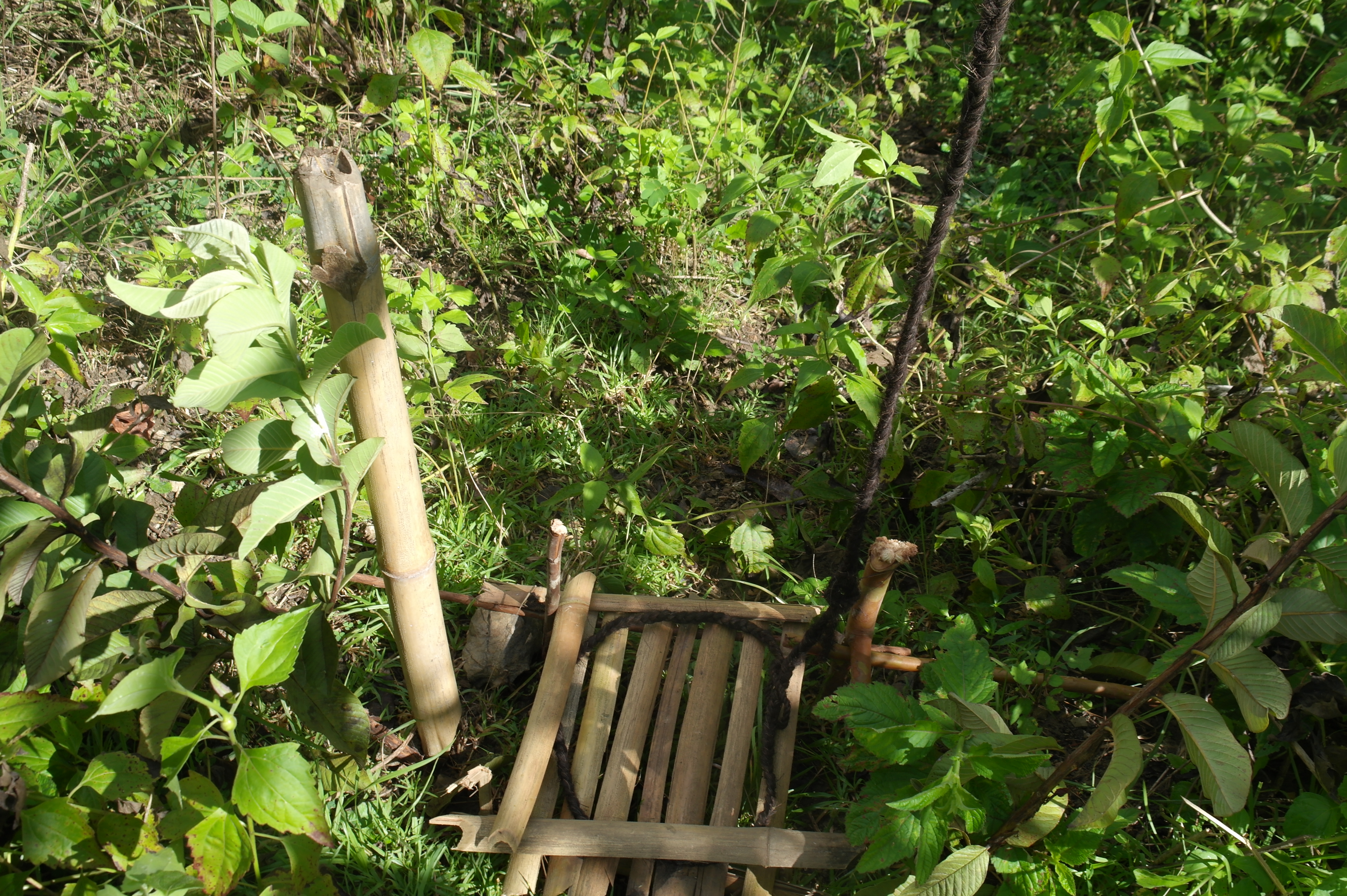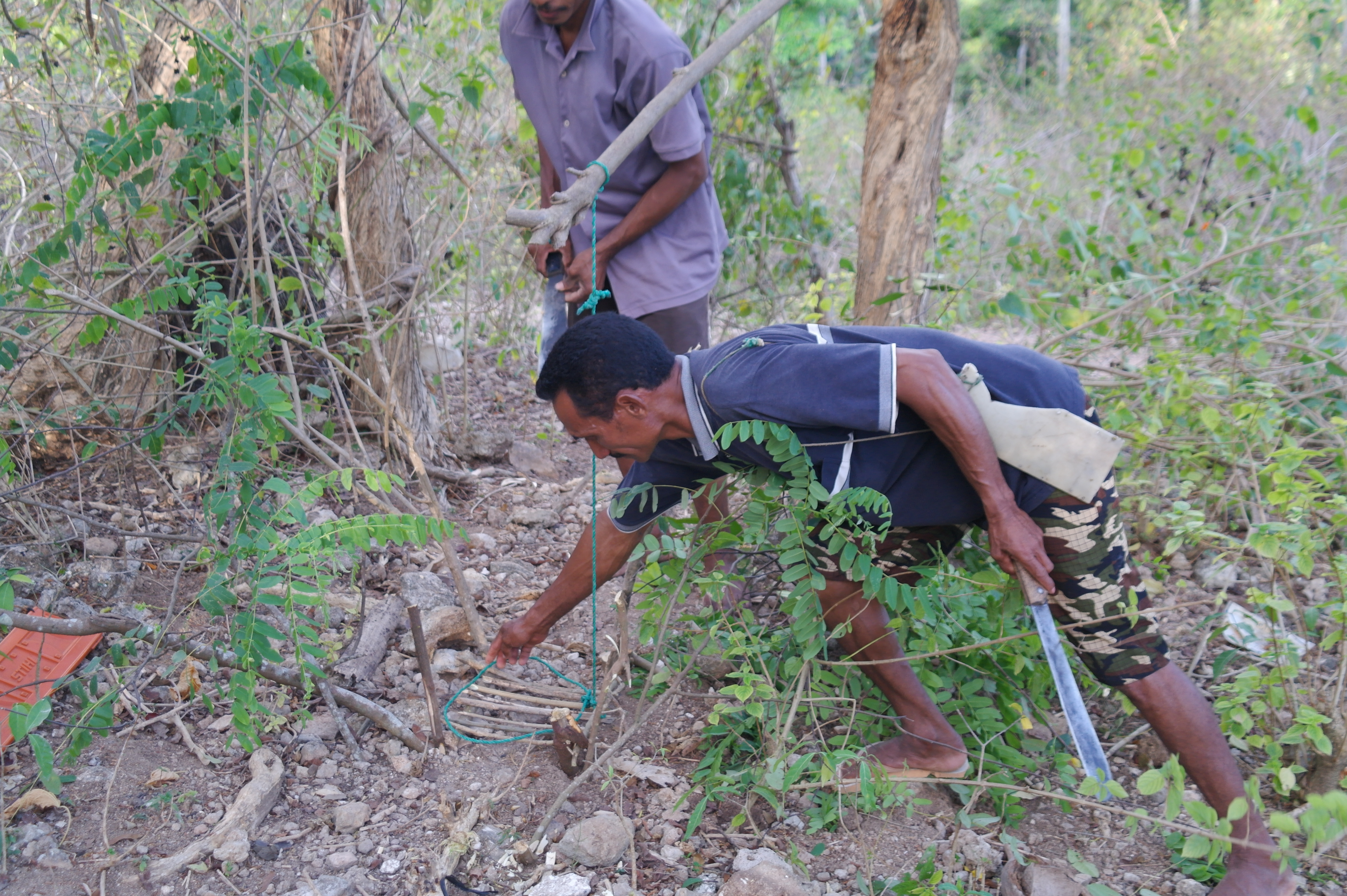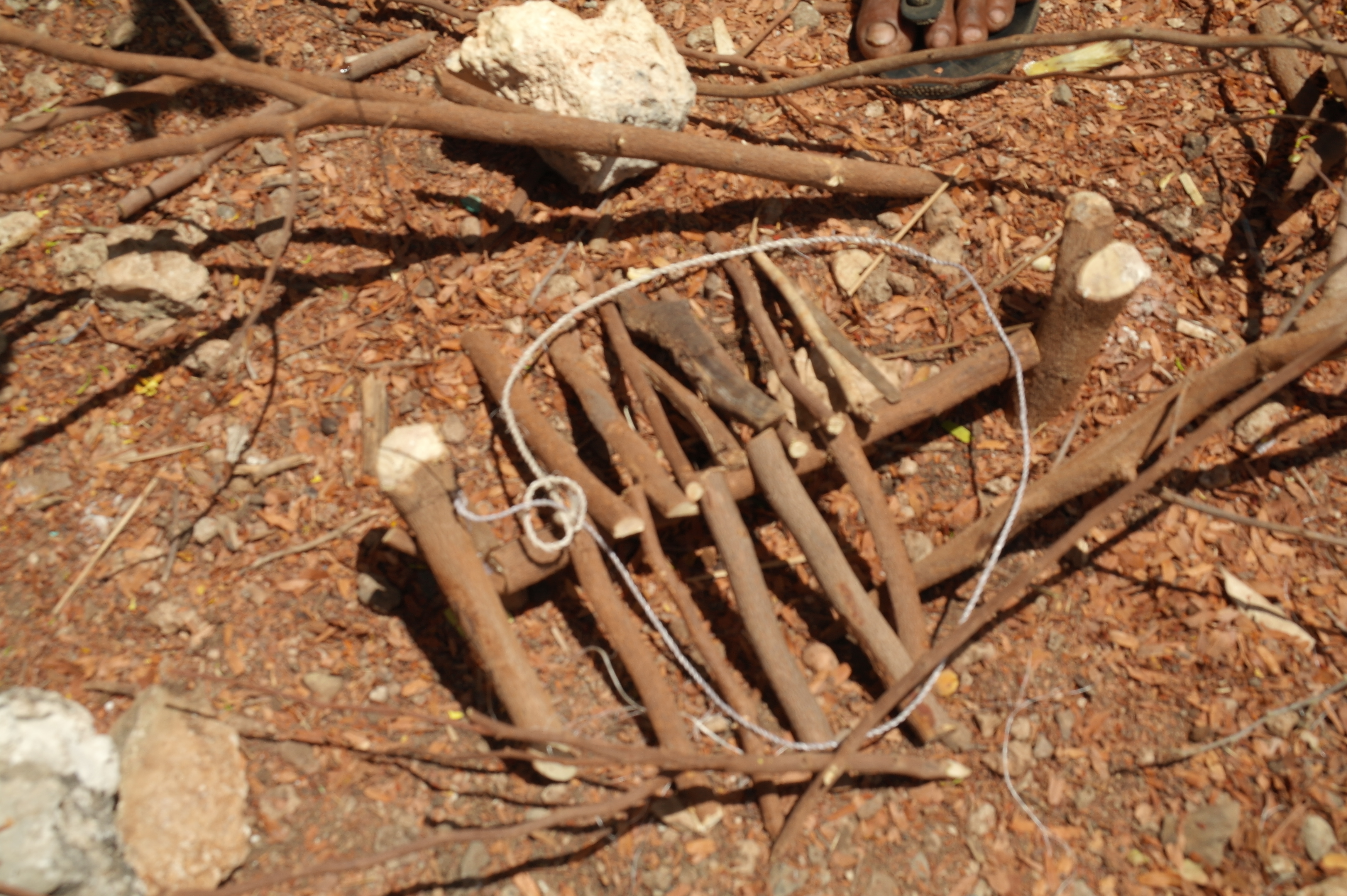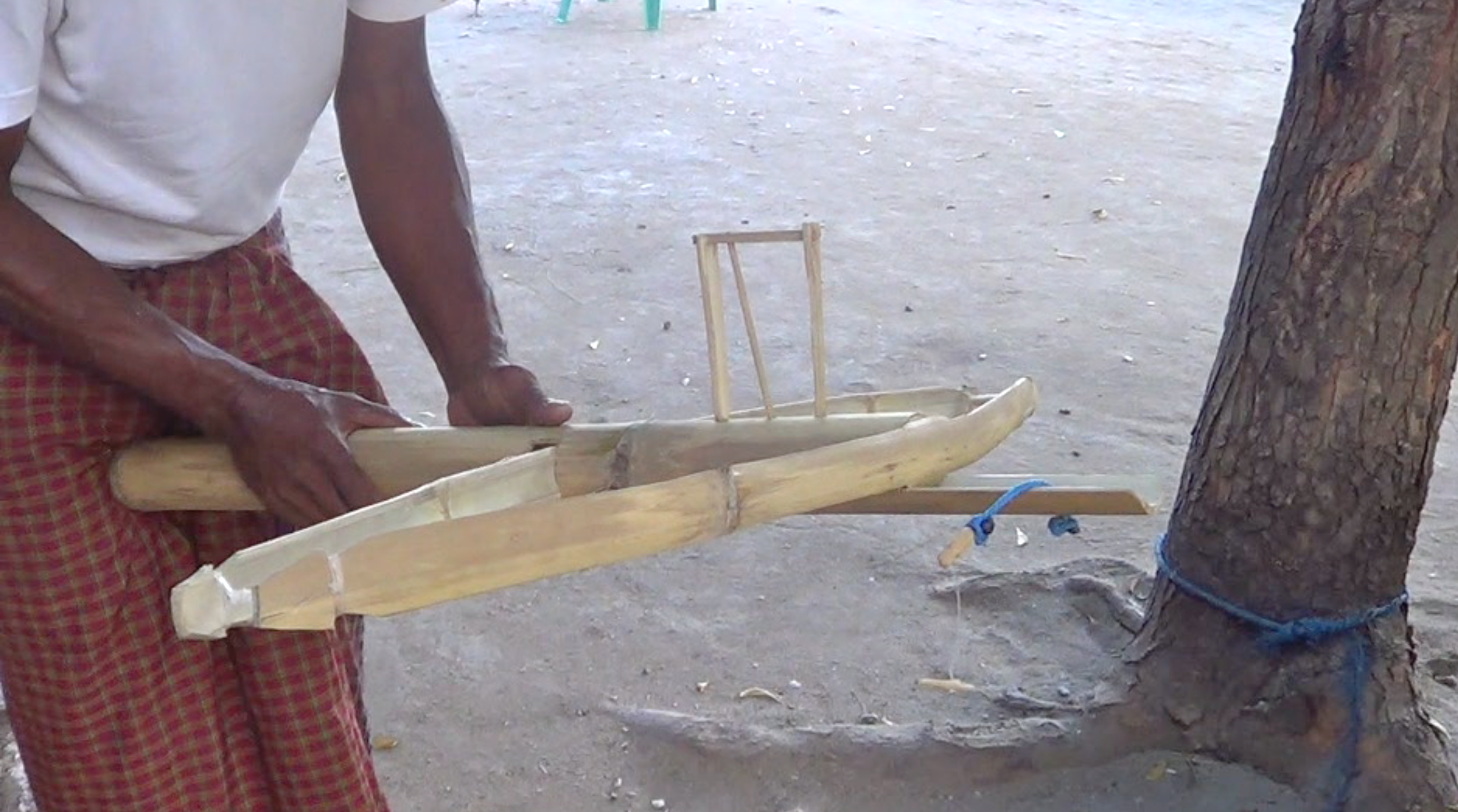Traps (hiil fa'i)
A number of different types of hiil fa'i, traps, were evident across the Lautem district. Hiil fa'i are used by Fatuluku tribes to catch wild jungle animals for meat or for use as work animals. Hiil fa'i demonstrated by Orlando Baptista in aldeia Paiira, sub-district Lospalos, are used to catch larger animals such as boars or deer. Hiil fa'i involves a length of strong rope, which is at one end tied to a tree branch, and at the other end, a loop of rope is fitted over pieces of bamboo pegged into the ground. Loose lengths of bamboo form a square creating a raised surface that, when stepped on by an animal, fall away and the rope is released from where it is held in place by the bamboo pegs and jerks up towards the tree, capturing an animal's foot. The more an animal moves to get away, the tighter the rope becomes. To force an animal through the trap, larger bamboo tubes are pegged into the ground of either side of the trap, and assumedly food is place near the trap to entice animals. The rope and bamboo are covered with leaves to hide the trap and disguise the smell.
Photo: Orlando Baptista making a hiil fa'i in aldeia Paiira, sub-district Lospalos.
Photo: Evansto da Graca and Januario Pinto making hiil fa'i in aldeia Horo Lata, subdistrict Lospalos.
.jpg)
Photo: Miguelina Xavier weaving a roso hina in aledia Mu'a Pusu, sub-district Lautem.
Respondents reported learning to make traps from their parents, and noted that perceived threats to transmission include that young people today prefer to use air rifles for hunting.
Sejumlah hiil fa’i, jebakan, dengan dengan jenis berbeda merupakan bukti yang tersebar di Distrik Lautem. Hiil fa'i digunakan oleh suku Fataluku untuk menangkap sejumlah binatang liar untuk diambil dagingnya atau digunakan sebagai binatang pekerja. Hiil fa'i yang ditunjukan oleh Orlando Baptista di Desa Paiira, Distrik Lospalos, digunakan untuk menangkap hewan besar seperti babi hutan dan rusa. Hiil fa'i menggunakan tali yang panjang lagi kuat, salah satunya terikat pada cabang pohon, sementara ujung lain lubang tali dipasang pada potongan bambu yang dipatok di tanah. Bambu berbentuk persegi menciptakan permukaan yang lebih tinggi. Saat terinjak oleh hewan, pasak bambu akan tersentak ke arah pohon dan menangkap kaki binatang buruan. Semakin banyak binatang tersebut bergerak, semakin kencang pula ikatan tersebut. Agar hewan melalui perangkap, tabung besar dipatok di tanah pada kedua sisi perangkap, umpan dipasang di dekat perangkap. Tali dan bambu ditutupi dengan daun untuk menyembunyikan perangkap dan menyamarkan bau.
Hiil fa’i dengan rancangan yang sama dibuat oleh Enasto da Graca dan Januario Pinta di Desa Horo Lata, Lore II. Sebuah batang kayu terikat pada batang pohon, menciptakan cabang pohon baru. Gagang akhir tempat batang kayu diikat ke pohon, diberi pemberat batu untuk menjaga agar cabang tetap horizontal. Sebuah lubang tali longgar diletakkan di atas potongan bambu yang dipatok ke tanah. Antara pasak bambu ini, panjang longgar bambu membentuk persegi menciptakan permukaan yang lebih tinggi, ketika terinjak oleh hewan, tali dilepaskan oleh pasak bambu dan tersentak ke arah pohon, menangkap kaki hewan.
Di Desa Soikili, Parlamento, sebuah Hiil fa'i yang ditemukan tampaknya digunakan untuk hewan kecil, kemungkinan musang atau cusus. Hiil fa'i berbentuk 'tenda' kecil dari potongan-potongan kayu. Dua kayu bentuk segitiga yang dipatok ke dalam tanah, dan tongkat kayu dipasang ke dalam 'Y' segitiga. Melekat pada salah satu ujung tongkat adalah tali, yang ujungnya diikat ke atas pohon. Tongkat diletakan di tempat dengan kekencangan tali, sisa tali memegang tongkat di tempat membentuk lingkaran longgar. Di atas tongkat, diletakan di antara dua pasak kayu, adalah potongan pendek kayu di kedua sisi tongkat, menciptakan bentuk seperti tenda. Ini adalah bentuk dasar perangkap. Di atas perangkap kayu ini adalah lubang longgar tali yang terbungkus. Saat binatang melangkah ke perangkap, tali tersebut tersentak ke arah pohon, menangkap hewan dengan kakinya.
Perangkap tikus, dinamai cura hiil fa’i, dibuat di Desa Loho Matu, sub-distrik Lautem. Perangkap tikus digunakan untuk menangkap tikus yang memakan hasil panen. Perangkap dibuat dari bambu berlubang yang dipotong dengan panjang sekitar 50 cm. salah satu ujung diblokir, sementara ujung lainnya adalah pembuka bagi tikus untuk masuk. Pada ujung yang terbuka, ‘baki’ sepanjang 10 cm, atau bagian bawah bambu yang tersisa, digunakan untuk membuat tikut masuk perangkap. Dua bilah bambu yang panjang, tipis dan lentur digunakan untuk membuat jepitan perangkap.
Bagian tengah bambu yang dipotong menciptakan lubang agar jepit dapat masuk ke dalam. Jepit lainnya yang berada pada mulut lubang bekerja untuk memerangkap tikus di dalam ketika perangkap terpicu. Perangkap dipicu dengan kayu panjang yag menggantung ke dalam perangkap dari lubang di bagian atas. Ketika memasuki perangkap, tikus akan menggerogoti dan mencoba menarik makanan yang melekat pada sepotong kayu. Hal ini akan memicu perangkap, sehingga penjepit bawah akan menutup mulut perangkap – tikut terperangkap. Pembuat cura hiil fa'i belajar bagaimana membuat perangkap dari kerabat laki-laki. Dia mengatakan bahwa ancaman terhadap keberadaan perangkap tikus yang jarang digunakan ini adalah lantaran masyarakat saat ini menggunakan racun untuk membunuh tikus.
Can't find what you're looking for? Try viewing the site map.



